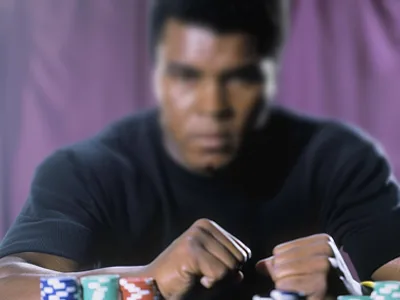In 1974, Muhammad Ali shocked the world by beating the undefeated heavyweight champion George Foreman using the “rope a dope” strategy: leaning against the ropes, absorbing punishment, and letting his opponent exhaust himself before striking back.
Modern poker players would do well to apply the same lesson when facing the aggressive regulars that have become so commonplace in today’s game. Although these players have rightly assessed that aggression is the most powerful skill set for a poker player to have, they often apply it indiscriminately. They attack every perceived weakness, fire multiple barrels every time they can, and assume that pressure alone will be enough to get the job done. Their mistake is believing that aggression is more important than table awareness, and that opponents who seem weak always are.
This is where the rope-a-dope strategy can act as a powerful counterattack against them. Here’s how to use it to your advantage.
Step One: Identify your opponent
You know the one. That player at the table who thinks they can win every pot. They raise every button, play every blind, and seem to bet whenever they’re given the opportunity. Some will be so obvious that you’ll have no problem marking them, while others will require you to put a little more effort—watch a few more showdowns—to recognize them as such. Either way, once you have them marked as a rope-a-dope candidate, the fun begins.
Step Two: Stay aware of your perceived range
The rope-a-dope strategy works best when your opponent perceives you as being weak. This means understanding exactly how your lines and betting patterns look to an aggressive regular who’s on the hunt for weaknesses to exploit.
Generally speaking, this is how an aggressive reg will analyze an unknown player’s actions: when they limp preflop, they’re weak. When they call a raise instead of 3-betting, they’re weak. When they check-call the flop as the opener, they’re weak. When they make small bets on wet boards, they’re weak.
Knowing that, we can start to rope a dope by massaging our “range” (aka all the hands we could have in that spot). We can bet small on dynamic boards, expecting them to raise. We can flat an open with a big hand, expecting them to squeeze behind. We can slow-play our monsters, even at the risk of losing value. Our job is to identify spots where our perceived range (what it looks like we have) is much weaker than our actual holdings.
Step Three: Attack
Unlike in boxing, in poker, the attack portion often requires no action at all. Our jab followed by a right cross is the check button followed by clicking call.
Take a hand where you opened AJs from the cutoff and called your aggressive opponent’s button three-bet.
The board runs out AQ92 with two spades on the flop (you have no spades in your hand) and you check-call flop and turn bets from your opponent. Now the river is an ugly ten of spades, bringing in the front-door flush draw and putting you behind hands like KJ, AT, TT, and QTs. Facing a standard 2/3 pot river bet, this is a hand many inexperienced players (and even some experienced ones) massively overfold.
According to poker solvers, you should be calling AJs more than 50% of the time. Even hands like A4s and A3s without a flush are supposed to call an astounding 90% of the time. And that’s in a vacuum without any reads!
What this means is that when we’re up against a player we’ve marked as aggressive, we can rope-a-dope them not just with our nutted hands, but with our middling hands as well—even when the river scare card comes in.
In these moments we have to remember: aggressive regs aren’t worried about losing a buy-in while barreling off. The way they see it, if you had a hand like AA/QQ/AK/AQ or even a flush draw, you are likely to have taken an aggressive action somewhere earlier in the hand. This means that, to them, you seem “capped” to your exact holdings. And when that’s the case, you should expect them to attack.
So, the next time you’re at, or near the top of, your range—like you are with AJ—remember to recognize the player-type you’re up against, employ the rope-a-dope strategy like a boss, and just click call.

